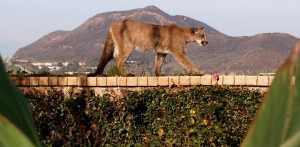Photogenic lion meets with untimely demise
NPS blames rodenticide poisoning
Source of this article: The Thousand Oaks Acorn, October 15, 2015
A mountain lion found dead Sept. 30 within the boundaries of Point Mugu State Park has been identified as Puma-34, a juvenile female who was photographed last year walking across a backyard wall in Newbury Park.
Based on the preliminary results of a necropsy, which showed significant amounts of free blood in the lion’s chest cavity and around its heart, National Park Service biologists believe the animal’s cause of death to be rodenticide poisoning. P-34 was just under 2 years old.
Often used by homeowners and businesses, anticoagulant rodenticides can lead to uncontrolled bleeding in wildlife. Lions are typically exposed to the chemicals when they eat rodents that have eaten the poison.
Kate Kuykendall, NPS spokesperson, said officials suspect poisoning was the cause of death, “but we’re not 100 percent sure. We still have to wait for toxicity results.”

During Happier Times — The female mountain lion shown here in a photograph taken last December by local resident Sherry Kempster was found dead Sept. 30 in the Boney Mountain Wilderness Area. Known as Puma-34 to the National Park Service, which tracks the animal, the cougar was just under 2 years old.
The body of the mountain lion was discovered by a local runner in the middle of Fossil Trail in the Boney Mountain Wilderness Area. The runner alerted state park rangers, who in turn notified the National Park Service, which researches and tracks the animals to aid in their survival.
Though wounds were discovered on the cougar’s face and body, signs that it had recently been in a fight, the injuries were superficial, the park service said.
P-34 earned global fame last December when it was photographed by Newbury Park resident Sherry Kempster crossing her backyard wall, a mountain in the background.
The photo appeared on websites for the Washington Post and London’s Daily Mail, among many others.
Later that day the young mountain lion wound up underneath a mobile home near the 101 Freeway in Newbury Park.
When Fish and Wildlife officials could not coax the lion out, it was tranquilized. Before it was relocated, NPS researchers placed a tracking collar around its neck.
Although P-34 didn’t receive its collar until last December, Kuykendall said the park service had been tracking the cougar since it was 3 weeks old.
“We tracked her while she was still with her mom, who was collared,” Kuykendall said.
P-34’s sibling, P-32, was struck and killed by a vehicle on Interstate 5 in August after making a journey out of the Santa Monica Mountains.
Kuykendall said the deaths are a reminder of the challenges faced by the local mountain lion population, which is estimated to be between 30 and 40. Ten are being tracked with collars by the park service.
“It’s tough to be a mountain lion, especially in the Santa Monica Mountains, and because the population here is surrounded by urbanization they have to deal with so many challenges. Rat poison is just one of them,” Kuykendall said.
In addition to P-34, two other young mountain lions have been found dead in the Santa Monica Mountains in recent weeks, according to the park service.
Last month, NPS biologist Jeff Sikich found the remains of P-43 and a previously unknown sibling in a remote part of the mountain range to the east.
The kittens, just 3 months old, had been killed by another predator, the park service said.
Researchers hope forensic DNA results from UCLA, due back in the near future, will shed light on the species of animal involved in the attack and may even identify the specific individual—if it was one of the study’s collared mountain lions.
If it turns out it was a cougaron cougar attack, it wouldn’t be the first.
Infanticide is a form of intraspecific conflict, which is the No. 1 cause of death of mountain lions since the park service began studying the animals in 2002.



1 Comment
Steve · October 15, 2015 at 11:38 pm
There was another photo in the article, of the dead mountain lion lying in the middle of the trail. If you would like to see it, follow the link at the top to the article in the TO Acorn.